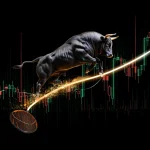Investor Panic: When They Flee, You Buy
“When fear grips the market, the fool retreats, but the wise see it as the ultimate invitation to act.”
March 23, 2025
It’s a familiar scene: headlines scream doom, pundits predict disaster, and investor panic spirals into a frenzy. Yet, beneath this veneer of chaos lies a profound truth—panic breeds opportunity. The moment the herd succumbs to irrational fear, a select few, armed with discipline, technical acumen, and psychological insight, capitalize on market mispricings that can yield extraordinary returns. This essay explores how investor panic, though destructive for many, creates a fertile ground for those prepared to navigate it with a clear, analytical mind.
The Anatomy of Investor Panic
Investor panic is not a sudden anomaly but the inevitable product of a complex interplay between market forces and human psychology. At its core, panic is a reaction to uncertainty—a desperate attempt to regain control in a rapidly shifting environment. History has shown us that during times of crisis, irrationality prevails. From the dot-com bubble burst in 2000 to the financial meltdown of 2008 and, most recently, the market turmoil during the COVID-19 outbreak, panic has always precipitated a sharp decline in asset prices.
When investors panic, their actions are driven not by logic but by emotion. They sell at the first sign of trouble, often at prices that fail to reflect the underlying value of assets. A vicious cycle ensues in the process: selling begets more selling, and prices plummet further. This mass exodus creates temporary market inefficiencies and lays the groundwork for future recoveries.
But here’s the twist: while the majority of investors are paralyzed by fear, a subset of market participants see beyond the hysteria. These investors understand that panic is cyclical—a predictable response to extreme uncertainty. They know that every market downturn carries within it the seeds of its own reversal and that with each dramatic sell-off, the door to substantial gains swings wide open.
Behavioral Psychology: The Engine of Market Overreaction
To comprehend investor panic, one must first delve into behavioural psychology. Humans are not rational beings; cognitive biases and emotional triggers deeply influence our decision-making processes. Nobel laureate Daniel Kahneman’s research on loss aversion reveals that the pain of losing money is psychologically about twice as powerful as the pleasure of gaining it. This bias often leads investors to make knee-jerk decisions during market downturns, selling assets in a frantic bid to avoid further losses.
Another crucial factor is the availability heuristic—our tendency to overemphasize immediately available information. When grim headlines dominate the news, it’s easy for investors to become overwhelmed by the negative narrative, ignoring the fact that markets are inherently cyclical. This emotional contagion, amplified by social media and 24-hour news cycles, can turn a minor correction into a full-blown panic.
Mass psychology further exacerbates this situation. When one investor sees another selling in panic, the impulse to follow suit becomes almost irresistible. This herd behavior creates a self-reinforcing cycle of selling that drives prices down to unsustainable levels. Meanwhile, those with the discipline to recognize these psychological traps can turn a crisis into a strategic opportunity.
Technical Analysis: The Roadmap Amid Chaos
While psychology explains why panic occurs, technical analysis offers a systematic way to navigate it. Chart patterns, moving averages, and momentum indicators serve as objective tools that help investors discern the underlying trends amid the noise of market hysteria.
Take, for instance, the phenomenon of support and resistance. In times of panic, prices often plummet toward established support levels—a psychological floor established by previous buying activity. These support levels act as a buffer, preventing prices from falling indefinitely. Savvy investors monitor these levels closely, using them as signals for potential buying opportunities when the market becomes oversold.
Moving averages, such as the 50-day and 200-day averages, provide further clarity. When prices dip below these averages, it signals that the market’s momentum is shifting, but such technical breakdowns are often temporary. For the astute investor, a dip below a moving average may represent a bargain rather than a warning sign. By combining technical analysis with understanding behavioural biases, investors can time their entries and exit with greater precision, effectively turning market panic into a strategic advantage.
Consider the market reaction during the COVID-19 crisis in March 2020. While most investors scrambled to cut losses, those monitoring technical indicators noted that the S&P 500 had oversold and approached critical support levels. These signals, corroborated by the Relative Strength Index (RSI) indicating an oversold condition, prompted a well-timed accumulation of quality assets. When the market rebounded, these investors reaped substantial rewards, validating the power of a disciplined, technical approach during chaos.
The Philosophy of Contrarian Investing
Investing is as much an art as a science, and nowhere is this more evident than contrarian investing, which is the practice of going against prevailing market sentiment. Philosophers have long argued that wisdom lies not in following the crowd but in questioning its assumptions. In the financial realm, this wisdom translates into recognizing that investor panic is less a signal of doom and more a harbinger of opportunity.
The contrarian investor is a modern-day Socrates, questioning the conventional wisdom that dominates during market crises. When the masses panic, driven by fear and short-term uncertainty, the contrarian sees a landscape where assets are mispriced and opportunity abounds. This mindset is not born out of arrogance but a clear understanding of market cycles. History shows that during every major downturn, those who dare to act against the tide tend to emerge as the big winners.
This approach is not without risk. Going against the herd requires a robust conviction in one’s analysis and a willingness to endure isolation while the rest of the market capitulates. But as the adage goes, “Fortune favors the bold.” In times of investor panic, the most daring and disciplined investors are rewarded, while those who cling to conventional wisdom are left holding the bag.
Case Studies: Learning from the Past
It helps to examine real-world examples to fully grasp the dynamics of investor panic. Consider the financial crisis of 2008. The panic was widespread as Lehman Brothers collapsed and the market spiralled downward. Yet, amidst the chaos, investors like Warren Buffett and other seasoned contrarians were quietly accumulating stocks at deep discounts. Their willingness to buy when everyone else was selling preserved their capital and eventually led to some of the most lucrative gains in modern market history.
Another striking example is the tech bubble burst of the early 2000s. As internet stocks plummeted, panic ensued, wiping out vast sums of paper wealth. Those with the foresight to recognize that the fundamentals of many solid companies remained intact seized the moment. Over the next decade, the market recovered and soared to new heights, rewarding those who dared to invest during the nadir.
More recently, during the height of the COVID-19 pandemic, we witnessed a dramatic plunge in global markets. Investor panic led to an indiscriminate sell-off, yet those who kept cool and focused on technical indicators saw a clear signal: oversold conditions created buying opportunities. By sticking to a disciplined strategy that integrated technical analysis and an understanding of market psychology, these investors were well-positioned to capitalize on the subsequent recovery.
The Fusion of Strategies: A Blueprint for Success
The magic happens when behavioural psychology, mass psychology, and technical analysis are fused into a coherent strategy. The seasoned investor doesn’t rely solely on gut instinct or random market timing. Instead, they develop a framework that integrates market behaviour’s emotional and analytical aspects. This multidimensional approach provides a robust defence against the pitfalls of panic while highlighting opportunities others overlook.
For instance, an investor might start by analyzing market sentiment using indicators such as the CNN Fear & Greed Index or the AAII Investor Sentiment Survey. These tools provide a snapshot of the market’s collective mood. When sentiment reaches extreme levels—either overwhelming fear or irrational exuberance—it often signals an impending reversal.
Next, the investor turns to technical analysis. By examining key support and resistance levels, moving averages, and momentum indicators, they can pinpoint the exact moments when panic-induced sell-offs create value. Finally, they overlay these insights with an understanding of behavioural biases, recognizing that the market’s reactions are often exaggerated and cyclical.
This fusion of strategies creates a formidable blueprint for success. It transforms the chaos of investor panic into a structured, predictable process that offers clear entry and exit points, minimizes emotional decision-making, and ultimately leads to more consistent, long-term gains.
The Role of Independent Thinking and Discipline
At the heart of this approach is independent thinking. The ability to think independently is invaluable in a world where the media and market pundits thrive on sensationalism. The seasoned investor understands that the loudest voices are often the most misleading. They rely on their analysis and judgment rather than succumbing to the collective hysteria.
This independent mindset is bolstered by discipline. It’s one thing to recognize an opportunity during a market panic, but it’s another to have the discipline to act on that recognition. The most successful investors maintain a steady hand amidst the storm, sticking to their strategies even when market sentiment is overwhelmingly negative.
Discipline also means patience. The rewards of contrarian investing are not always immediate. There will be periods of extended uncertainty, where the market appears stuck in a downward spiral. But the eventual recovery can be spectacular for those who dare endure these moments.
Moreover, this discipline extends beyond just investment decisions. It permeates every aspect of the investor’s approach—from risk management to portfolio rebalancing. By continuously monitoring market indicators and their emotional responses, wise investors cultivate self-awareness to navigate even the most volatile market conditions.
Final Thoughts: Embracing the Chaos
So, is investor panic a harbinger of ruin, or is it an invitation to seize opportunity? The answer is clear: panic creates pain for the fool but generates unparalleled opportunity for the wise. Amid the chaos, while the herd succumbs to fear, the independent and disciplined investor stands ready to act.
The true test of an investor’s mettle is not during calm times but in panic. When markets are at their lowest, when the noise of fear is deafening, that is when the wise truly shine. They understand that investor panic is not a permanent state but a temporary anomaly—a momentary blip in the grand cycle of market evolution.
Embrace the chaos. Learn from it. Let it refine your strategy and sharpen your instincts. By blending the insights of behavioral psychology with the precision of technical analysis and by maintaining an unwavering commitment to independent thought, you transform moments of crisis into stepping stones for lasting wealth.
In this high-stakes arena, the difference between success and failure lies in your ability to see through the fog of panic. It’s not about being the loudest voice in the room; it’s about being the one with the clearest vision. When panic strikes, only those truly prepared—those who have mastered the art of disciplined, independent thinking—will survive and thrive.
Remember, while the fool is overwhelmed by investor panic, the wise investor finds opportunity in every crisis. In a world where chaos is the only constant, let your strategy be your shield and your insight your sword. The future favours those brave enough to act when others freeze, bold enough to invest when fear is rampant, and disciplined enough to remain uncertain.
The Blueprint for Bold Thinking













